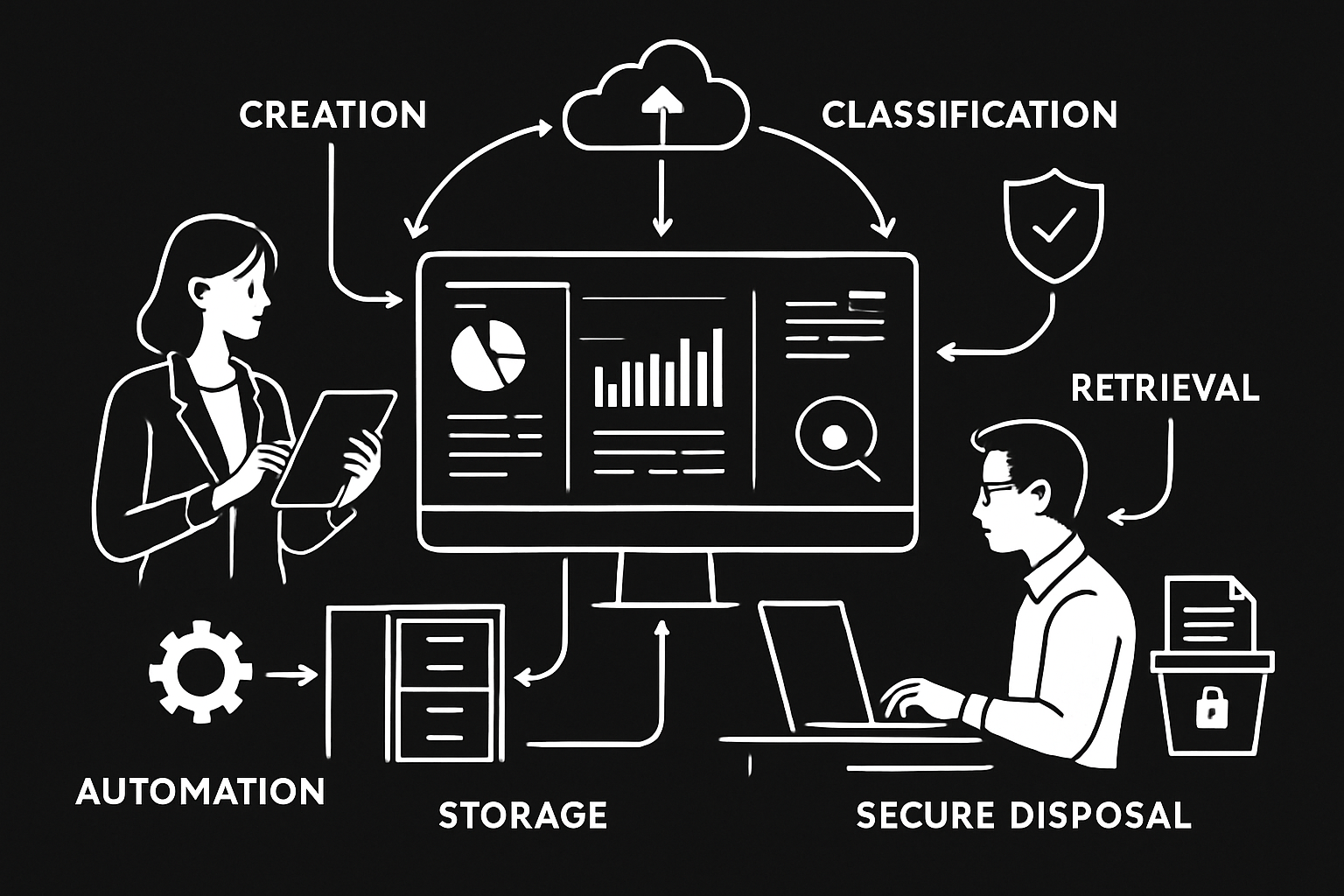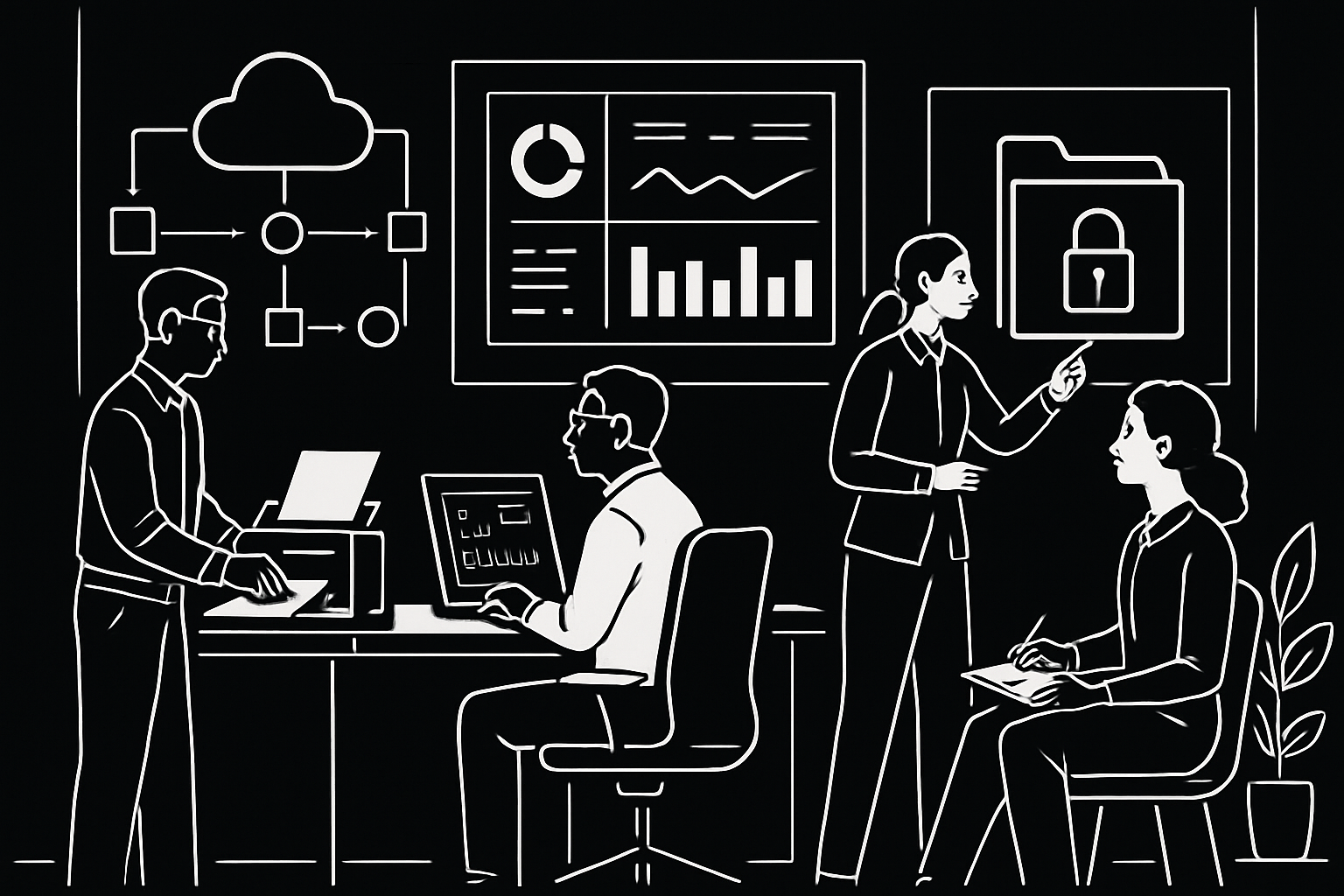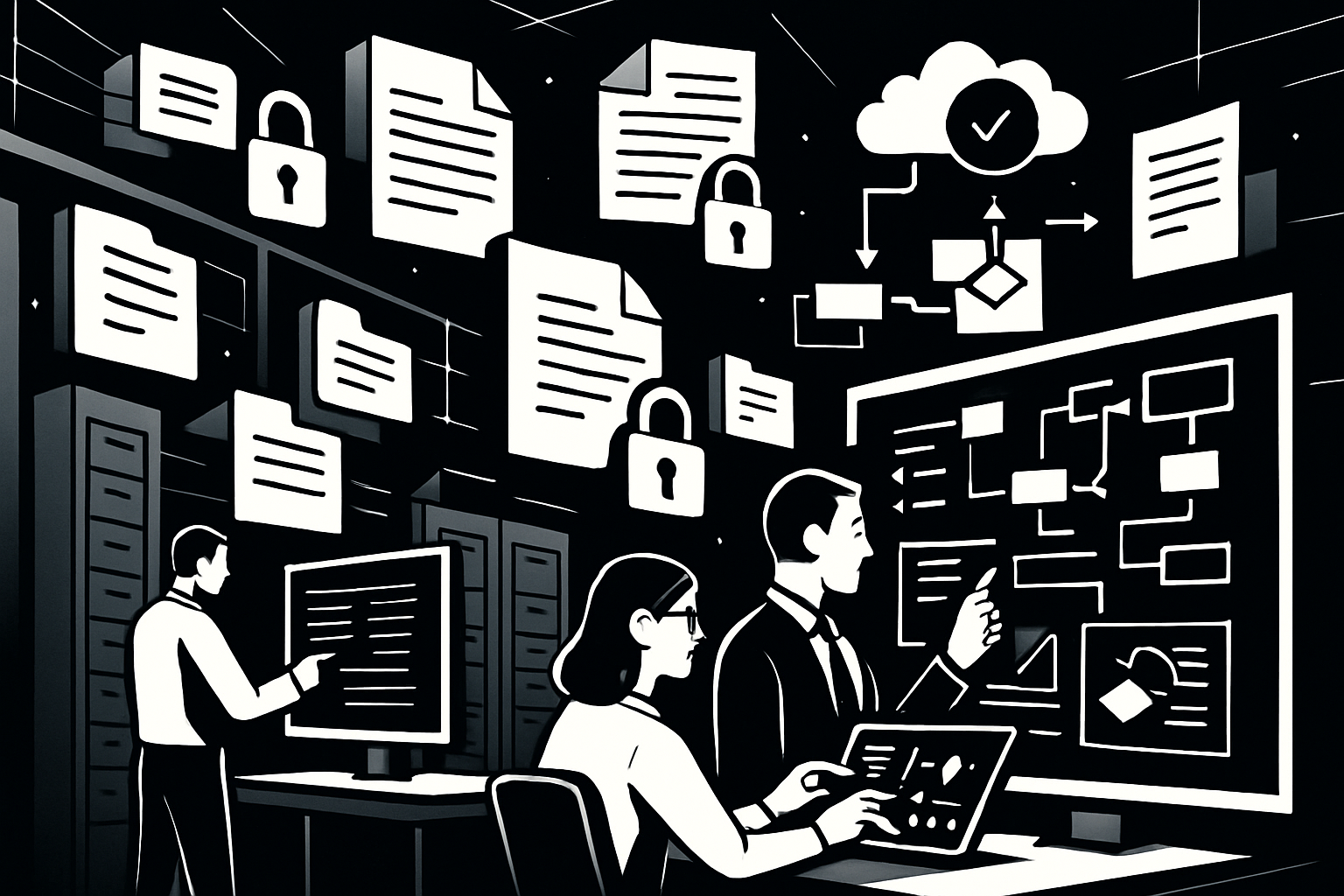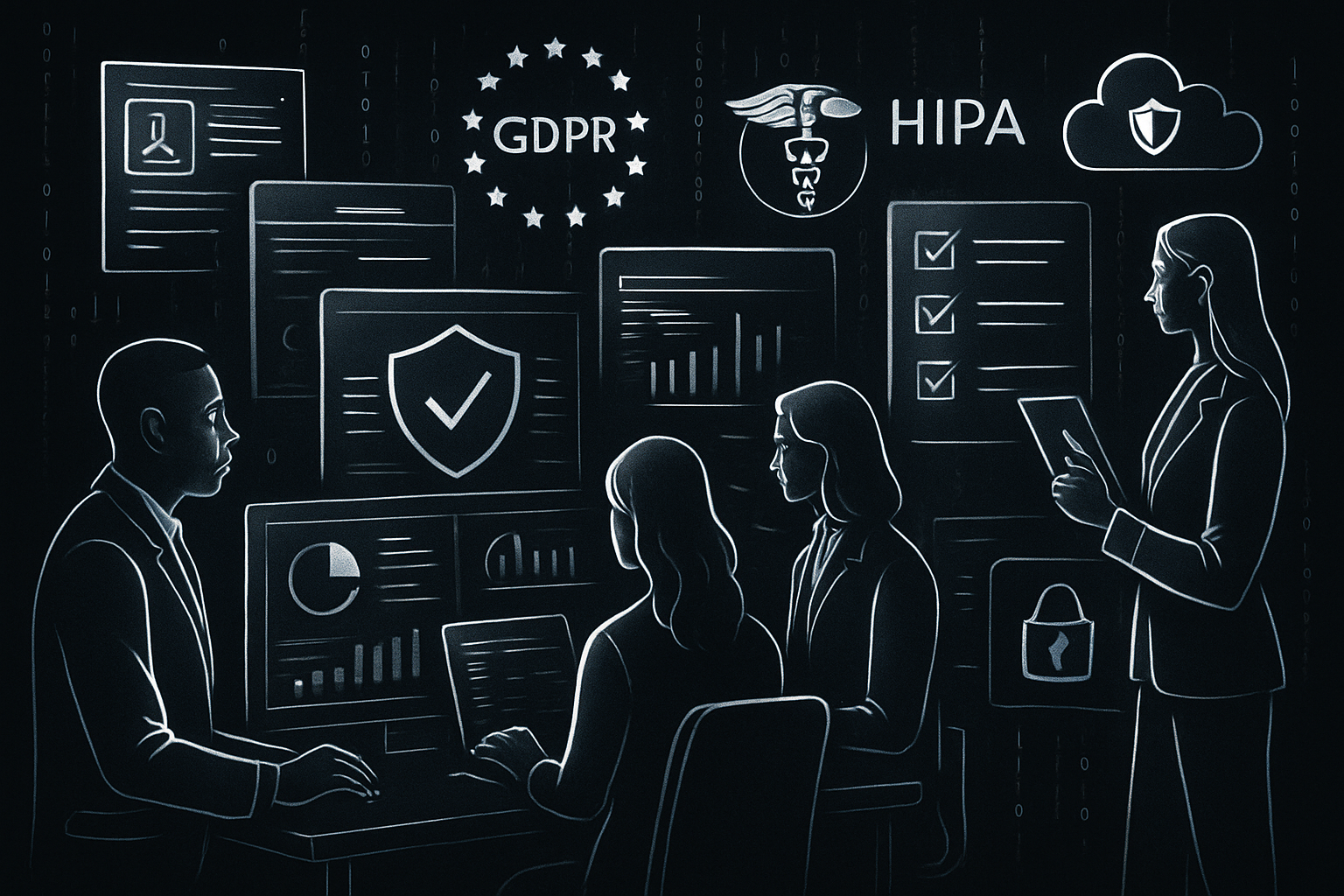The world is experiencing a data explosion, with global data creation expected to surpass 180 zettabytes by 2025. For businesses, this surge means that managing information is more critical than ever.
Poor document management has a high price. Studies show organizations can lose up to 21.3% in productivity and waste thousands of dollars per employee each year.
Companies today face mounting challenges. These include compliance risks, data breaches, and inefficiencies from outdated or fragmented systems.
A modern record management system offers a solution. It can streamline operations, ensure regulatory compliance, and safeguard sensitive information.
In this guide, you’ll discover best practices for record management systems in 2025. We’ll cover system types, features, implementation steps, compliance strategies, and future trends.
Understanding Record Management Systems: Types and Core Features
Keeping up with the explosion of business data means having the right tools. A record management system is no longer a luxury—it's a necessity for organizations facing growing compliance demands, security threats, and productivity pressures.

Defining a Record Management System (RMS)
A record management system (RMS) is an end-to-end solution designed to manage records throughout their entire lifecycle. From creation and classification to retention, retrieval, and secure disposal, an RMS automates processes that once relied on manual, paper-based methods.
Unlike traditional filing systems, a record management system offers scalability, advanced security, and automation. It also differs from an Electronic Document Management System (EDMS), which focuses mainly on document storage and retrieval. An Electronic Document Records Management System (EDRMS) goes further, managing compliance and retention policies.
Modern platforms like RecordPoint provide a cloud-native record management system, positioning RMS as the central nervous system for business information governance.
Types of Record Management Systems
Organizations can choose from several types of record management system depending on their needs:
- Physical RMS: Paper-based systems, still common in healthcare and legal sectors.
- Electronic RMS: Digital platforms for storing and managing records.
- Hybrid RMS: Combines physical and digital records, often requiring integration strategies.
- Cloud-native RMS: Delivers remote access, scalability, and advanced security features.
Many businesses are migrating from physical or hybrid setups to cloud-native record management system solutions for better flexibility and security.
Core Features of Modern RMS
A modern record management system comes packed with features to streamline record handling:
- Automated classification and retention scheduling.
- Secure disposal processes.
- Advanced metadata management and search tools.
- Workflow automation for approvals and routing.
- Comprehensive audit trails and activity logs.
- Seamless integration with enterprise tools like ERP, CRM, and email.
Popular solutions such as Box, Laserfiche, and SharePoint provide workflow automation and robust compliance tools within their record management system offerings.
Key Benefits of RMS Adoption
Implementing a record management system delivers several advantages:
- Complete control over data assets.
- Improved compliance with regulations like GDPR, SOX, and HIPAA.
- Enhanced data protection and lower breach risk.
- Major productivity gains: Employees spend 30% of their time searching for documents, which an RMS can drastically reduce.
- Significant cost savings, especially by cutting paper-related expenses.
These benefits make a record management system central to any organization's efficiency and regulatory strategy.
Common RMS Challenges
Despite the advantages, deploying a record management system comes with hurdles:
- Managing both physical and digital records in hybrid environments.
- Adapting to constantly changing compliance requirements.
- Addressing data security and potential vulnerabilities in the cloud.
- Avoiding costly violations, as recordkeeping failures cost US businesses $1.235 billion in 2022.
Overcoming these challenges means selecting the right record management system and continuously refining policies and processes.
Step-by-Step Guide to Implementing a Record Management System in 2025
Implementing a record management system in 2025 is more than just adopting new software—it’s a holistic transformation of how your organization handles information. A well-executed approach ensures compliance, reduces risk, and boosts productivity. Let’s break down the process into clear, actionable steps.

Step 1: Identify Organizational Needs and Objectives
Begin by assessing your current record management system practices. Which processes create bottlenecks? Where do compliance gaps exist? Map out your organization’s regulatory requirements, whether you operate in healthcare, finance, or another sector.
Consider how your record management system will need to scale as your business grows. Identify integration needs with other platforms, like CRM or ERP systems. By understanding your unique landscape, you lay the foundation for a system that truly fits your workflow and compliance demands.
Step 2: Choose the Right RMS Solution
Next, compare available record management system solutions. Will you deploy on-premises, choose a hybrid setup, or go cloud-native? Evaluate vendors based on essential features, security certifications, and support capabilities.
Examine the user interface and automation features. Can the system integrate with your current software stack? For Microsoft-centric businesses, SharePoint is a strong option, while OpenText serves large-scale enterprises. The right record management system should match your team’s needs and future-proof your investment.
Step 3: Develop a Comprehensive Records Policy
Now, craft a detailed policy that defines what records you manage, how long to keep them, and who can access them. Set clear retention schedules and access controls within your record management system.
Establish procedures for creating, storing, and securely disposing of records. Assign roles and responsibilities, ensuring accountability at every stage. For example, use retention labels and legal holds in SharePoint to automate compliance. A strong policy keeps your record management system effective and audit-ready.
Step 4: Migrate and Classify Existing Records
Take inventory of all records—both physical and digital. Audit their relevance and compliance status. Digitize paper documents using scanning and OCR tools to make them searchable within your record management system.
Classify and tag records with metadata for easy retrieval. Leveraging AI-powered indexing, like DocuPhase, can automate much of this work. By doing so, you reduce the stress of searching for documents and ensure your information is always accessible and organized.
Step 5: Configure and Customize the RMS
With your records imported, configure workflows for approvals, retention, and disposition. Set up integrations between your record management system and business tools like email, ERP, or CRM platforms.
Customize dashboards to monitor compliance and activity. Tailor reporting features to your industry’s regulatory needs. Platforms like NewgenONE offer lifecycle tracking tools that provide vital visibility, making your record management system a powerful engine for governance.
Step 6: Train Staff and Promote Change Management
A record management system is only as strong as its users. Develop comprehensive training for employees and administrators. Use e-learning platforms and hands-on sessions to build confidence and competence.
Foster a culture of compliance and continuous learning. Address resistance by highlighting the benefits of the record management system, such as time savings and improved data security. Ongoing support ensures lasting adoption and maximizes your investment.
Step 7: Monitor, Audit, and Continuously Improve
Finally, implement regular audits and compliance checks within your record management system. Use analytics to uncover bottlenecks or inefficiencies and to spot opportunities for optimization.
Update your policies and configurations as regulations evolve. Automated audit logs and risk detection features in modern systems help you stay ahead of compliance risks. Continuous improvement keeps your record management system agile and effective in a changing landscape.
Best Practices for Record Management System Success in 2025
Implementing a record management system is only the beginning. To truly unlock its value, organizations must adopt proven best practices that keep records organized, secure, and compliant. Let’s explore the essential strategies every business should follow to make the most of their record management system.

Establish Clear Policies and Procedures
A successful record management system starts with strong policies. Define how records are created, named, retained, and disposed of. Make policies accessible and ensure staff know where to find them.
- Document all processes and update them regularly.
- Assign clear roles and responsibilities.
- Use retention schedules that align with regulations.
Organizations that prioritize clear procedures and benefits of keeping information organized see fewer compliance issues and greater efficiency. Regular policy reviews ensure your record management system adapts as needs evolve.
Automate Where Possible
Manual processes slow down productivity and introduce risk. Modern record management system platforms offer workflow automation that streamlines approvals, retention, and notifications.
- Automate repetitive tasks like document routing.
- Use AI-powered tools for redaction and metadata tagging.
- Set up alerts for retention deadlines.
Automation reduces errors and frees up staff to focus on higher-value work. By leveraging automation, your record management system becomes a true engine for operational efficiency.
Ensure Robust Security and Access Controls
Protecting sensitive information is critical in any record management system. Set up role-based access so only authorized users can view or edit specific records. Apply encryption to keep data safe.
- Enable audit trails to track all user activity.
- Use real-time alerts to detect suspicious actions.
- Require multi-factor authentication for system access.
With these controls in place, your record management system guards against both internal and external threats. Regularly review permissions to ensure compliance and security.
Stay Proactive with Compliance and Legislation
Regulations change rapidly, and a record management system must keep pace. Monitor new laws and update your RMS policies to remain compliant.
- Implement legal holds and automated retention schedules.
- Use machine learning to identify high-risk records.
- Perform regular compliance audits.
A proactive approach helps your organization avoid costly penalties and maintain trust. By integrating compliance tools into your record management system, you turn regulatory challenges into opportunities for improvement.
Manage Hybrid and Legacy Records Effectively
Many businesses still juggle physical and digital records. A robust record management system should integrate both, enabling unified control.
- Digitize paper files using scanning and OCR.
- Centralize storage for easier access and management.
- Develop clear procedures for hybrid environments.
Overcoming hybrid challenges ensures your record management system delivers a seamless experience. Centralization reduces risk and boosts productivity by making all records searchable and accessible.
Regular Training and User Engagement
Technology is only as effective as its users. Ongoing training ensures staff understand how to use the record management system and follow best practices.
- Offer e-learning and support resources.
- Gather feedback to improve usability.
- Celebrate adoption milestones to encourage engagement.
Engaged users are more likely to follow policies and maximize the system’s value. Continuous education closes gaps and keeps your record management system running smoothly.
Compliance, Security, and Risk Management in Modern RMS
Modern organizations face a complex web of compliance, security, and risk challenges. A robust record management system is no longer optional—it’s essential for protecting business-critical data and meeting regulatory demands. Let’s break down how a record management system can help you navigate these challenges in 2025.

Navigating Regulatory Requirements
The regulatory landscape is expanding rapidly. From GDPR and CCPA to HIPAA and SOX, each regulation places unique demands on data privacy, retention, and transparency. Failing to comply can lead to severe penalties, reputational damage, and operational disruptions.
In fact, recordkeeping violations cost US businesses $1.235 billion in 2022, underscoring the high stakes. A record management system enables organizations to track, report, and manage records in line with evolving requirements. By centralizing information, you reduce the risk of missing retention deadlines or mishandling sensitive data.
Leveraging RMS for Compliance
A modern record management system automates much of the compliance burden. It can:
- Enforce retention schedules
- Apply legal holds to preserve records under investigation
- Maintain detailed audit trails for regulators
With these capabilities, a record management system ensures data integrity and supports defensible disposition practices. Automation reduces human error, so your compliance processes are reliable and repeatable. When regulations change, updates can be rolled out across all records instantly, keeping your organization always compliant.
Security Best Practices
Protecting sensitive information is a top priority. The right record management system incorporates industry-standard security measures:
- Encryption of data in transit and at rest
- Multi-factor authentication (MFA) for all users
- Regular vulnerability assessments and penetration tests
These safeguards create strong barriers against unauthorized access. By monitoring user activity and setting granular permissions, your record management system helps prevent insider threats and data leaks. Security isn’t just a feature—it’s a foundation for trust.
Risk Management Strategies
Risk management is about preparation and resilience. A record management system can classify sensitive and high-risk data automatically, making it easier to prioritize protection.
Key strategies include:
- Disaster recovery planning with regular backups
- Business continuity protocols for rapid response
- Analytics to detect anomalous activity or potential threats
Advanced systems use AI to flag suspicious patterns, alerting you before a risk becomes a crisis. By integrating these features, your record management system becomes a proactive shield against data loss and compliance gaps.
Addressing Cloud Security Concerns
With many organizations moving to the cloud, security expectations are higher than ever. A cloud-native record management system should offer:
- Compliance with international standards (ISO 27001, SOC 2)
- Data residency and sovereignty controls
- Continuous monitoring and automated threat detection
When evaluating vendors, verify their certifications and data handling practices. A strong record management system in the cloud gives you both flexibility and peace of mind, ensuring your records are secure, accessible, and compliant—wherever your teams work.
Future Trends in Record Management Systems for 2025 and Beyond
The future of record management system technology is being shaped by rapid advances in AI, the growth of cloud solutions, and the ever-increasing volume of data. With global data creation projected to surpass 180 zettabytes by 2025, organizations must rethink how they manage, secure, and extract value from their records. Let’s explore the key trends that will define the next generation of record management system solutions.
Artificial Intelligence and Machine Learning
Artificial intelligence is transforming the record management system landscape. AI-powered tools are automating data classification, risk detection, and compliance monitoring. For example, machine learning algorithms can flag sensitive documents and predict retention schedules. Natural language search makes retrieving records faster and more intuitive. As data volumes explode, AI will help organizations keep pace, reduce manual work, and ensure accuracy in every aspect of their record management system.
Cloud-Native and Remote-First Solutions
The shift to cloud-native record management system platforms is accelerating. Businesses are embracing remote and hybrid work, demanding secure, accessible, and scalable solutions. Cloud-native RMS offer real-time collaboration, automated backups, and easy integration with other business tools. This trend reduces IT overhead and enables organizations to adapt quickly as needs change. The record management system is becoming the backbone of digital workplaces.
Integration with Enterprise and Productivity Platforms
Modern record management system tools are designed to connect seamlessly with enterprise software. Direct integrations with ERP, CRM, HR, and productivity suites eliminate data silos and streamline workflows. Unified dashboards provide a holistic view of information governance. Users can now manage records, approvals, and compliance tasks without leaving their primary business applications, making the record management system a true hub for enterprise efficiency.
Enhanced User Experience and Automation
User expectations for record management system platforms are rising. Intuitive interfaces, mobile access, and low-code customization are now standard. Advanced workflow automation handles approvals, retention, and disposition with minimal manual intervention. AI-powered suggestions and self-service portals empower staff to manage records efficiently. These enhancements drive adoption and maximize the return on investment for any record management system.
Evolving Compliance and Privacy Demands
Regulatory landscapes are shifting rapidly, with stricter data privacy and cross-border requirements emerging worldwide. Record management system vendors are responding by updating compliance features and automating policy enforcement. Organizations must stay proactive, using their RMS to track changes, apply legal holds, and demonstrate defensible disposition. This evolving environment demands continuous improvement and vigilance from every record management system.
Sustainability and Green IT
Sustainability is now a core consideration in record management system strategy. Digital transformation reduces reliance on paper, physical storage, and energy-intensive processes. Modern RMS help organizations meet ESG goals by supporting paperless operations and efficient resource use. Businesses adopting green IT practices with their record management system not only save costs but also contribute to a healthier planet.
Selecting the Right Record Management System: Comparison of Leading Solutions
Choosing the best record management system for your organization is a pivotal decision that impacts productivity, compliance, and security. With so many options available, the selection process can seem overwhelming. However, by following a structured approach and focusing on your unique requirements, you can find a solution that fits your business like a glove.
A record management system centralizes information, boosts efficiency, and guards your organization’s most critical data. Let’s break down how to evaluate, compare, and select the right platform to future-proof your records in 2025.
Evaluation Criteria for RMS Selection
Before diving into specific vendors, it’s essential to define what makes a record management system the right choice. Start by assessing your organization’s size, regulatory landscape, integration needs, and scalability requirements.
- Scalability: Can the system grow with your business and handle increasing data volumes?
- Security & Compliance: Does it meet industry standards like GDPR, HIPAA, or SOX?
- Automation & Integration: Are workflow automation and connectivity with tools like ERP, CRM, and email available?
- User Experience: Is the interface intuitive and customizable?
- Support & Pricing: Are training, documentation, and customer support robust?
Poor record management system choices can lead to significant productivity losses. In fact, organizations losing up to 21.3% in productivity due to poor document management highlights the real cost of inefficient systems. Prioritize features that streamline processes and minimize risk.
In-Depth Comparison of Top RMS Platforms
The record management system landscape is filled with powerful solutions. Here’s a quick overview of leading platforms:
- Box: Known for document storage, collaboration, 1,500+ integrations, and automation templates. Pricing starts at $15/user/month.
- DocuPhase: Offers cloud-based management, AI-powered indexing, and workflow automation. Strong AP automation and customizable permissions.
- Laserfiche: A comprehensive ECM suite with metadata classification, electronic forms, and both cloud/on-premises deployment.
- NewgenONE: Focuses on content services, records lifecycle management, and process automation, with seamless Microsoft integration.
- OpenText Extended ECM: Excels in automated classification, AI search, and deep integrations with Salesforce, SAP, and Microsoft.
- Revver: Provides automated storage, AI-powered redaction, and security policies for desktop, cloud, and mobile.
- SharePoint: Enterprise-level records management, Microsoft Copilot AI assistant, and robust compliance features.
Each record management system brings unique strengths, so align your choice with your top priorities.
Key Strengths and Differentiators
When comparing platforms, look at what sets them apart. Automation and AI are transforming how organizations manage records.
- Automation & AI: Box, DocuPhase, and OpenText lead with workflow automation and AI-driven search.
- Compliance & Security: Laserfiche, OpenText, and SharePoint excel in regulatory features and data protection.
- Integration: Box, SharePoint, and OpenText offer unmatched connectivity with enterprise tools.
- User Interface & Support: Laserfiche and Revver stand out for their user-friendly design and learning resources.
A record management system that combines these elements can dramatically improve compliance and operational efficiency.
Considerations for Niche and Industry-Specific Needs
Every industry has unique demands when it comes to a record management system. Highly regulated sectors such as healthcare, legal, and finance require granular compliance controls, audit trails, and legal hold capabilities.
Small and midsize businesses (SMBs) often prioritize affordability, ease of use, and essential features over complex customization. Hybrid and remote teams need cloud-native solutions for seamless collaboration and accessibility.
When selecting a record management system, map your must-have features to your sector’s pain points. For example, healthcare organizations may need HIPAA compliance, while legal teams focus on defensible disposition and secure access controls.
No matter your industry, ensure your record management system can adapt as regulations evolve and your data grows.
Real-World Examples and Use Cases
Organizations across industries are leveraging record management system platforms to drive transformation. For instance, companies digitizing legacy records have seen compliance improvements and reduced retrieval times.
Businesses using AI-driven RMS can now flag sensitive data and automate retention schedules, reducing manual workload and risk. Others are adopting paperless strategies, achieving both cost savings and environmental benefits.
Whether you’re a large enterprise or a growing SMB, a modern record management system unlocks new efficiencies and better protects your information assets.
Summary Table: Feature Comparison Matrix
Below is a quick-reference comparison of leading record management system platforms for 2025:
| Platform | Core Features | Deployment | Integrations | Compliance Certs | Pricing (USD/user/mo) |
|---|---|---|---|---|---|
| Box | Automation, collaboration, 1,500+ integrations | Cloud | ERP, CRM, Microsoft | SOX, GDPR | $15+ |
| DocuPhase | AI indexing, workflow, AP automation | Cloud | Accounting, ERP | GDPR, SOC 2 | Custom |
| Laserfiche | ECM, forms, workflow, metadata | Cloud/On-prem | Microsoft, Salesforce | HIPAA, SOX, GDPR | $45–$50 |
| NewgenONE | Records lifecycle, automation, reporting | Cloud/On-prem | Microsoft apps | GDPR, ISO 27001 | Custom |
| OpenText Ext. ECM | AI search, classification, deep integration | Cloud/On-prem | SAP, Salesforce, MS | ISO 27001, SOC 2 | Custom |
| Revver | AI redaction, storage automation, security | Cloud/Desktop/Mob | Google, Microsoft | GDPR, SOC 2 | Custom |
| SharePoint | Retention, legal holds, Copilot AI | Cloud | Microsoft 365, Teams | SOX, GDPR | $36 (MS 365) |
Selecting the right record management system ensures your organization is prepared to meet tomorrow’s challenges with confidence and agility.
As you’ve seen, navigating the world of record management doesn’t have to be overwhelming—especially when you have the right tools and best practices at your fingertips. If you’re ready to take the next step in organizing your family’s important paperwork and plans, why not simplify everything in one place? With The Family Binder, you can keep your financial accounts, insurance details, and estate plans all neatly organized and easily accessible. Give yourself (and your loved ones) some peace of mind for the future—Download Now.

